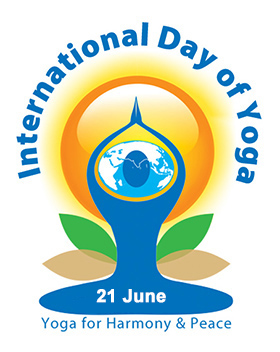When 21 June was first declared as International Day of Yoga (IDY), it was accepted warmly by most countries of the world. However, in India, a small section of the intelligentsia was opposed to the idea. Their understanding was that this was an attempt to ‘Hinduise’ India. Of course, the IDY has met with great acceptance among the common citizens of India.
It may not be redundant to put a few facts in place. Yoga is a shared heritage of India with strong components of it present in Jainism and Buddhism and elements present even in other religions. Secondly, practice of Yoga does not necessitate any religious affiliation. It can be practiced by all, notwithstanding one’s religious convictions. In this sense, Yoga is a universal spiritual practice, cutting across superficial differences. And historically, it has been a shared tradition in India. The purport of this essay is to demonstrate this.
It is, firstly, important to understand the meaning of Yoga. Today, by Yoga we commonly understand Hatha Yoga or yogasanas, which were systematized by the Yogis of the Nath sampradaya. This is what people publicly practice on the International Day of Yoga. By Yoga some better-informed people understand Patanjal Yoga system. This is one of the six astika schools of philosophy of India. The principal treatise of this school is the Yogasutra composed by the sage Patanjali around 200 BC. However, it is important to know and remember that Patanjali merely systematized a method or way of enlightened living that was already in practice in India for several centuries before him. Yoga essentially means union. It is a method of joining oneself to and remaining joined to one’s true nature which is pure and immutable. Meditative practices help one achieve this goal. And a pre-condition for success in Yoga is strict adherence to ethical precepts.
As mentioned, the origin of Yoga goes back to several centuries before Patanjali. Today, different figurines found in the Indus Valley Civilization have been regarded as yogic postures or asanas. The philosophy and practice of Yoga is to be found in a number of minor Upanisads that have been later classified as the Yoga Upanisads. Some of these Yoga Upanisads are: Sandilya Upanisad of Atharva Veda, Yogatattva Upanisad of Krishna Yajur Veda, Dhyanabindu Upanisad of Sama Veda, Hamsa Upanisad of Sukla Yajur Veda, Amritanada Upanisad of Krishna Yajur Veda, Mandalabrahmana Upanisad of Sukla Yajur Veda, Nadabindu Upanisad of Rig Veda and Yogakundali Upanisad of Krishna Yajur Veda.i
Since Yoga is a means of joining one to one’s true self or nature, especially through meditative practices, it is found in a big way in both Jainism and Buddhism. The Yogadrishtisamuchchaya (8th century AD) of Haribhadra Suri compares several Yoga schools from a Jaina perspective. The author “aligns Patañjali’s eightfold scheme with three others (including one of his own) and also measures each against the traditional Jaina fourteenfold path to liberation. In addition, he describes four different sects of Yogis current at his time and states emphatically that any Yogis who become involved with goddess worship or Tantra run the risk of making no spiritual advancement.”ii Christopher Key Chapple writes: “The Yoga system of Patañjali provides the template upon which Haribhadra erects the Yogadṛṣṭisamuccaya. Patañjali’s system, based on Sāṃkhya philosophy, incorporates several key Buddhist practices and aspects of Jaina philosophy. By the time of Haribhadra, it had gained broad respect for its ability to integrate a wide array of religious practices without allowing itself to be dismissed as ideological or dogmatic.”iii Haribhadra is also the author of Yoga Bindu. Several centuries later, another Jaina, Hemachandra, wrote the Yoga Sastra, also known as Adhyatma Upanisad.
The pre-eminent place of Yoga within Buddhism is well-known. Meditation is the method of gaining clarity and eventually the cessation of the cause of suffering. According to Christopher Key Chapple, “The Brahma Vihāras in the Yoga Sūtra (the cultivation of friendliness, compassion, sympathetic joy, and equanimity [I :33]) derive directly from the teachings of the Buddha…The emphasis on suffering or duḥkha, found in Yoga Sūtra pāda II, correlates directly to the first truth of the Buddha. The release from suffering for Buddhism is found in right view, right resolve, right speech, right action, right livelihood, right effort, right mindfulness, and right concentration (samādhi). Patanjali offers a similar eightfold practice of precepts, observances, movement, breath, inwardness, concentration, meditation, and samādhi. In the later Mahāyāna Buddhist tradition, we find that dharma megha samādhi is considered to be the tenth and highest level attained by the bodhisattva. Similarly, dharma megha samādhi plays a central role in Patanjali’s system.”iv Furthermore, the Mahayana Buddhist school of Yogacara, systematized by Vasubandhu and Asanga, emphasize meditation and the practice of Yoga as fundamental to the attainment of Enlightenment. Yogacara literally means ‘the practice of yoga’. Vajrayana or Tantric Buddhism also shares many things in common with Hatha Yoga, like the veneration of the guru and meditation on the chakras.
Sikhism too assimilated various aspects of classical Yoga. The Guru Granth Sahib discusses Hatha Yoga. “Guru Nanak uses the word Yoga to refer to his own religious system, which he calls “Gurmukh Yoga,” “Gurmat Yoga,” or “Sahaja Yoga.” The Sikh scriptures make frequent reference to the Sāṃkhya and Yoga theories of puruṣa and prakṛti. Concepts and practices from the later Haṭha Yoga traditions are also recognized, such as prāṇa, kuṇḍalinī, and the ṇadīs.”v Guru Nanak is believed to have visited the centres of the Gorakhnath school of Yoga across India up into Afghanistan to convince them to give up what he considered their “selfish individualism” and acknowledge the preeminence of God or Akal, the timeless purusa.vi
Yoga had a considerable influence on Indian Islam as well. When the Muslims invaded India and established their rule, Muslim scholars spent considerable time in translating Hindu texts. In his Tahqiq-i-Hind (India), Alberuni refers several times to Patanjali’s Yoga Sutra. He himself translated into Arabic a commentary on the Yoga Sutra. In fact, Alberuni’s text, “which is cast as a dialogue between Patanjali and an ascetic roaming in the deserts and the forests” is of particular interest because it diverges on many points from the extant Sanskrit-language commentaries of its time, and because a number of the sutras contained in Patanjali’s original works are missing.”vii The Laghu Yogavasistha, which is a Vedantic text, but includes various Yoga practices, was translated into Persian by Nizam al-Din Panipati for the Mughal Emperor Jahangir. The text Amritakunda, of which the original Sanskrit or Hindi is lost, discusses yogic physiology and practices and was translated into Arabic as Hawd mā al-hayāt. This text was widely translated into Persian, Turkish and Urdu and provided the basis for the practice of Sufi Yoga.
References:
i See K. Narayanaswami Aiyar, trans., Thirty Minor Upaniṣads, ed. by Madhu Khanna, Tantra Foundation, New Delhi, 2011.
ii Christopher Key Chapple, Reconciling Yogas: Haribhadra’s Collection of Views on Yoga, State University of New York, Albany, 2003, p. 18.
iii Ibid., p. 15.
iv Christopher Key Chapple, Yoga and the Luminous: Patanjali’s Spiritual Path to Freedom, State University of New York, Albany, 2008, p. 12.
v Ibid., p. 13
vi Ibid., p. 13
vii David Gordon White, The Yoga Sutra of Patanjali: A Biography, Princeton University Press, Princeton, 2014, p. 154.
Image Source: https://www.un.org/en/events/yogaday/











Post new comment